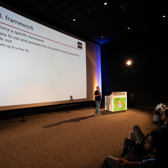Developing for the Power Platform with Microsoft Dataverse
UCDSD
5 days
Interested in a private company training? Request it here.
Not ready to book yet? Request an offer here.
Extensibility Overview
The goal of this module is to provide participants with an overview of the Microsoft Dataverse architecture and where the extension points are as a developer.
- Introduction to Dataverse
- Overview of the Dataverse Extensibility Model
- Overview of the Power Platform Developer Tooling
- Introducing XrmToolBox
- Introducing the Power Platform CLI
- LAB: Setting up your Development Machine
Working with the Dataverse Web API
The Dataverse Web API is one of two web services you can use to work with data and metadata in Dataverse. The other is the Organization Service. The Dataverse Web API provides a development experience that can be used across a wide variety of programming languages, platforms, and devices to access the Dataverse data and functionality. In this module, students will learn about the authentication and authorization options with the Dataverse Web API.
- Introduction to the Dataverse Web API
- Registering Client Applications with Azure Active Directory
- Authenticate with the Dataverse Web API using OAuth 2.0 and MSAL
- Performing a Simple Create Operation using the Dataverse Web API
- Composing HTTP Requests and Error Handling
- Dataverse Web API URL and Versions
- The Different HTTP Methods and Headers
- Executing your First HTTP Requests
- LAB: Creating and Configuring a Client Application for Dataverse using .NET
Using the Dataverse Web API
The Dataverse Web API provides a modern, RESTful web service you can use to interact with data and metadata in Dataverse using a wide variety of platforms, programming languages and devices. This module teaches students how they can execute CRUD operations, Actions and Functions using the Dataverse Web API.
- Query Data using the Dataverse Web API
- Creating, Updating and Deleting Rows in Tables
- Impersonate Another User using the Dataverse Web API
- Detect Duplicate Data using the Dataverse Web API
- Batch Processing with the Dataverse Web API
- LAB: Using the Dataverse Web API
Working with the Dataverse Service Client SDK
This chapter introduces participants to the Dataverse Service Client SDK and will teach them how to do CRUD operations in .NET using late or early binding. The Dataverse Service Client SDK is a cross platform SDK based on .NET that allows you to access the Dataverse Web API.
- What is the Dataverse Service Client SDK
- The IOrganizationService Interface
- Using the ServiceClient Class to Connect to Microsoft Dataverse
- Use Connection Strings to Connect to Microsoft Dataverse
- Early versus Late Binding when Accessing Table Rows
- Generating Entity Classes using the Power Platform CLI
- Create, Update, Delete and Retrieve Table Rows using the ServiceClient
- Querying Microsoft Dataverse using the QueryExpression and QueryByAttribute Classes
- Executing Batches using ServiceClient
- LAB: Writing a Dataverse Client Application using the Dataverse Service Client SDK
Querying Microsoft Dataverse with FetchXML
When accessing Dataverse as a developer you have several ways to query for data. In this chapter you will learn the syntax of the FetchXML language to query Dataverse.
- Introduction to FetchXML
- Writing FetchXML Queries
- Using XrmToolBox FetchXML Builder to Create FetchXML Queries
- Executing FetchXML Queries using the Dataverse Web API
- Executing FetchXML Queries using the Dataverse Service Client SDK
- LAB: Creating and Executing FetchXML Queries
Plug-ins
A plug-in is custom business logic that you can deploy inside Dataverse to modify or augment the standard behavior of Dataverse. This chapter teaches students how they can write a custom Plug-in in .NET and deploy it to Dataverse. Students also learn how to debug Plug-ins in Dataverse.
- Introduction to the Microsoft Dataverse Event Framework
- Plug-in Overview
- Writing Custom Plug-Ins
- Register and Deploy Plug-Ins using the Plug-In Registration Tool
- Debugging Plug-Ins in the Dataverse
- Deploying Plug-Ins with Solutions
- Automate Plug-in Deployment using Spkl
- Using Plugin Trace Viewer in XrmToolBox
- LAB: Creating and Deploying a Plug-in
Azure Integrations
Microsoft Dataverse supports integration with Azure. Developers can register plug-ins with Dataverse that can pass runtime message data, known as the execution context, to one or more Azure solutions in the cloud. Besides writing a custom Plugin, Azure is the only other supported solutions for communicating runtime context to external line-of-business (LOB) applications.
- Overview of the Azure Integration with the Dataverse
- Integration with Azure Service Bus
- Configuring the Azure-aware OOB Plug-In
- Write a Custom Azure-Aware Plug-In
- Integration between Microsoft Dataverse and Web Hooks
Creating and using Custom APIs and Actions
Use Custom APIs to create your own APIs in Dataverse. With a Custom API you can consolidate a group of operations into an API that you and other developers can call in their code.
- Introduction to the Microsoft Dataverse Event Framework
- Executing Messages via the Web API
- Executing Functions and Actions using the Web API
- Creating Custom Actions
- Creating Custom APIs
- Registering and Testing Custom APIs using XrmToolBox
- Using Custom APIs and Actions with the Web API
- Using Custom APIs and Actions in Power Automate
- Working with Business Events
- LAB: Implementing a Custom API
Client scripting in Model-Driven Apps using JavaScript
Client-side scripting using JavaScript is one of the ways to apply custom business process logic for displaying data on a form in a Model-Driven App. In this chapter you will learn how the JavaScript Client API of a Model-Driven App can be used to interact with forms and views
- Creating JavaScript Web Resources
- Handling Form/View and Field Events
- Root Objects in the Client API Object Model
- Working with the Client API Execution Context Object
- The Client API Form Context Object
- Interacting with Forms and Attributes using the Client API Object Model
- The Client API Grid Context Object
- The Client API Xrm Object
- Best Practices in Writing client-Side Code
- LAB: Using Client-Side Scripting in Table Forms
Customizing the Command Bar in a Model-Driven App
The Command Bar is displayed above every form or view in a Model-Driven App. In this chapter you will learn about how you can customize the Command Bar by adding or removing Commands.
- Overview of the Command Bar
- Available Command Bars in Model-Driven Apps
- Classic versus Modern Commanding
- Working with Display and Enable Rules
- Creating a Custom Ribbon Action
- Pass Data or URL Parameters to a Ribbon Action
- Adding or Removing Commands in the Command Bar
- Using Ribbon Workbench to Customize the Command Bar
- Modern Commanding using the Command Bar Designer
- Creating Visibility Rules using Power FX
- Executing Power FX Commands
- LAB: Customize the Command Bar using Ribbon Workbench and the Modern Designer
Creating Web Resources
Web resources represent files that can be used to extend the Dataverse web application such as html files, JavaScript, and CSS, and several image formats.
- Web Resources Overview
- Building Custom HTML Web Resources
- Using the Xrm.WebApi JavaScript Object Model to Access, Create and Manage Records
- LAB: Working with Xrm.WebApi in Custom HTML Web Resources
This course will teach developers how they can extend Microsoft Dataverse and Model-Driven Apps with custom code.
Although Microsoft Dataverse and Model-Driven Apps have quite some out of the box customization options, many companies have requirements which can only be met by extending the existing feature set of Microsoft Dataverse. This course is specifically designed to help .NET and JavaScript developers learn the various development features of Microsoft Dataverse and Model-Driven Apps. And since most Dynamics 365 Apps like Sales, Services, Marketing, ... are just model-driven built using Microsoft Dataverse, this training also applies to developers who would like to extend their Dynamics 365 Apps with custom code.
This course is targeting developers who have little or no development skills with the Power Platform and Model-Driven Apps or Dynamics 365. Before attending the course, delegates must have the following prerequisite knowledge and experience:
- Basic understanding of Web development and Design
- Knowledge of a .NET Programming Language (C# or Visual Basic .NET) and JavaScript
- Working Knowledge of Model-Driven Apps and the Power Platform (power-user perspective)








